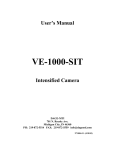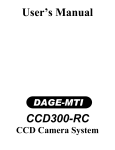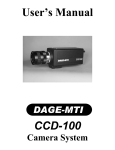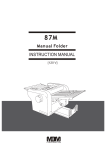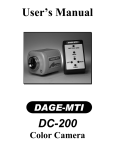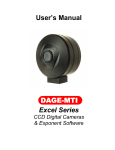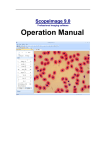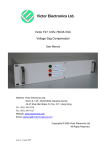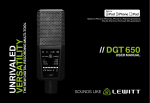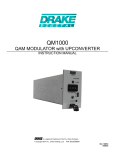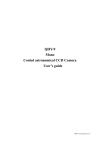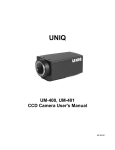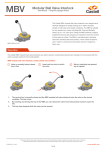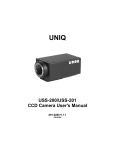Download User`s Manual
Transcript
User’s Manual DAGE-MTI IR-1000 IR CCD Camera Purchaser’s Record Model Name: DAGE-MTI IR-1000 Serial Number: Dealer’s Name: Dealer’s Address: Dealer’s Phone Number: Date Purchased: P.O. Number: Introduction The DAGE-MTI IR-1000 camera system is based upon a 1/2" Interline CCD that produces high-resolution imaging into the near IR spectrum. The CCD employs a state of the art microlens design to increase the light gathering capability of the CCD. The simplistic front panel design of the IR-1000 control unit allows easy access to the Gain and Black Level controls that provide a vast adjustment range. A Test switch provides a stair step pattern for rapid calibration or troubleshooting of the attached equipment such as a monitor or frame grabber. The read-out of the sensor can be inhibited by an external Gate pulse, which allows increased integration times in low-light level situations. The flexibility of the DAGE-MTI IR-1000 camera system makes it the camera of choice in almost any imaging situation. DAGE-MTI offers our customers state-of-the-art video technology… with an eye on your image. Installation The IR-1000 camera head connects directly into the control unit. Power for the control is supplied by an external switching supply that is provided. Ensure that a correct AC power cord is used in accordance with local safety standards. All power and interconnections to the IR-1000 camera head are supplied through the single interface cable. Gating can be accomplished by simply using the DAGE-MTI Investigater to control the gate time, display and store the image, or by using a computer with a frame grabber. Figure 1 shows some typical setups of the IR-1000. INVESTIGATER CONTROL UNIT VID OUT VID IN MONITOR 2 GATE COMPUTER 3 IR-1000 CCD CAMERA CONTROL POWER CORD GATE VID 1 CAMERA IR-1000 HEAD POWER POWER SUPPLY 1. IR-1000 VID OUT CONNECTED TO MONITOR. CAMERA OPERATION IN ‘NON GATING’ REAL TIME MODE. 2. IR-1000 CONNECTED TO INVESTIGATER CONTROL UNIT. GATING AND FRAME STORE OPERATION CONTROLLED BY INVESTIGATER CONTROL UNIT. 3. IR-1000 CONNECTED TO A COMPUTER. GATING AND FRAME STORE OPERATION CONTROLLED BY COMPUTER. Figure 1: IR-1000 Connections Figure 2: IR-1000 Control Rear Panel Power Connect the external switching supply to the rear panel's POWER connector and to a suitable power source in the range of 95VAC to 250VAC. Ensure that an approved AC cord is used to attach the supply to the AC mains. Camera This 12-pin ‘Hirose’ connector supplies all of the power and interface to the IR-1000 camera head. Always ensure that the camera head is attached to the control unit before turning the control unit on. NOTE: The interconnect cable between the camera head and the control unit has different sex connectors. The control unit end has a yellow stripe labeled “CCU”. Be certain to use the correct cable end at the control unit and head in order to avoid damage, which could void the warrantee. Video This ‘BNC’ connector supplies video output of the IR-1000 system. The signal is 1Vp-p terminated into 75Ω. Be careful to avoid double termination of the output video, which would result in incorrect video levels. Connect to a monitor, computer or the DAGE-MTI Investigater as required. NOTE: Do not use the VIDEO OUT connector on the camera head. This will cause incorrect video levels to be sent to the control and the signal at the camera head will be double terminated. Gate This ‘BNC’ connector can be used to provide input of a gate pulse in order to increase the sensitivity by inhibiting the readout of the CCD's image and allowing light to gather in the CCD for extended periods of time before readout. Connect to a computer or the DAGE-MTI Investigater. Operation Figure 3: IR-1000 Control Front Panel Power This switch controls the power to the IR-1000. The green light indicates when the power is on. Test The TEST switch provides a 10-step stair pattern for rapid calibration or troubleshooting of the attached equipment such as a monitor or frame grabber. With the TEST switch on, adjust the monitor or frame grabber until the whitest step is just under the point of saturation and the darkest step is as dark as possible while visible without clipping. Gain The GAIN of the IR-1000 can be either in a manually adjustable or in an automatic mode. In AUTO, the output of the camera is determined by the internal automatic gain control (AGC) circuitry, which will adjust the camera gain in order to keep the output signal at a full level. This is particularly useful when viewing low contrast highlights and rotating the Black Level control to stretch the low contrast highlights into a signal that is easier to examine. Black Level The black level output is determined by this control. When set to MAX, the output video resides on a standard 50mV black pedestal. The BLACK LEVEL control range allows blacks to be pulled down so that whites can be contrast enhanced and stretched. Using this mode with the GAIN control in AUTO stretches the portion of the signal that is of interest. When using external gating, the BLACK LEVEL control is useful for removing unwanted light offsets due to effects such as lens scattering and low level background light. Microscope Use A. Initial Set-up: 1. Set switches on rear of camera head as follows: SHUTTER to OFF, FIELD/FRAME to FRAME. 2. Use the TEST signal to adjust the associated equipment as outlined in the “Test” section on the previous page. B. All Forms of Transmitted Light: 1. Set GAIN to AUTO and BLACK LEVEL to MAX. 2. Adjust light so white highlights are just under saturation. 3. Turn BLACK LEVEL control for the proper contrast. C. Live or Real-time Fluorescence: 1. Set for best visual fluorescence using eyepieces. 2. Set GAIN to AUTO and BLACK LEVEL to MAX. 3. Turn BLACK LEVEL control for best black background. D. Gated low Light Level Fluorescence: 1. Follow steps 1-3 in part C above for live fluorescence. 2. Set GAIN to MAN and control to MIN. 3. Select Gate (Integration) time and initiate. Note: Increasing MAN GAIN can shorten the Gate time. However, this may cause the image to be very noisy. Gating The IR-1000 camera system can be externally gated in order to increase the sensitivity. Inhibiting the readout of the CCD's image allows light to gather in the CCD for extended periods of time. An external gating pulse defines the gate time of the camera through the GATE connector. Gating can be accomplished by simply using the DAGE-MTI Investigater, or by using a computer. If a computer is used, follow the timing recommendations as follows. The timing of the External Gate pulse requires that the pulse occur sometime during the field immediately before the CCD readout is to be inhibited. Figure 4 shows the relationship of the CCD transfer to the output video signal. Figure 4: Video to CCD Transfer Timing As long as the gate pulse edges occur before the CCD transfer, the correct timing will occur. Care should be taken to ensure that the CCD is gated for an even number of fields. If an odd number of fields are gated, the resultant image will differ in intensity between the two fields. To inhibit the readout of the CCD, simply ground the center pin on the GATE connector. The camera will readout the two fields immediately following the ground release of the CCD Gate signal. The CCD Gate input is compatible with standard CMOS type logic interfaces. Figure 5: External Gate Timing & Video Readout NOTE: When utilizing gating, the SHUTTER control on the Camera Head must be OFF and the FIELD/FRAME switch must be set to FRAME. Also the Control Units’ GAIN switch should be set to MAN, and the GAIN control should be set at MIN in order to keep the image from becoming too noisy. Electronic Shutter The IR-1000 camera system can be shuttered in order to decrease the sensitivity. If electronic shuttering is desired, turn the SHUTTER switch to ON and use the following diagram to set the SHUTTER SPEED switch. CAMERA HEAD REAR PANEL DO NOT USE SHUTTER SPEED VIDEO OUT DC IN/SYNC TO CONTROL OFF ON FIELD FRAME SHUTTER SHUTTER ON/OFF INTEGRATION MODE SHUTTER SPEED (SECONDS) 1/60(EIA) 1/100(EIA) 1/50(CCIR) 1/120(CCIR) 1/125 1/250 1/500 1/1000 1/2000 1/4000 1/10000 NOTE: THE BLACK SQUARE INDICATES THE SWITCH TAB POSITION Figure 6: Electronic Shutter Settings Connector Pin-outs Power This 5-pin ‘DIN’ connector receives DC power from the external switching power supply. The supply plugs into an appropriate AC outlet and provides all 35 241 of the necessary voltages to the IR-1000. Pin-out of the POWER Connector is as follows: PIN # 1 2 3 4 5 FUNCTION GND GND N/C -12V Power In (-12VDC @ 25mA) +12V Power In (+12VDC @ 275mA) NOTE: The external power supply has no user accessible parts. Refer maintenance to a qualified technician. Video The output video of the IR-1000 is present at this ‘BNC’ connector. The signal is 1Vp-p terminated into 75Ω. Care should be taken to avoid no termination or double termination of the output video, which would result in incorrect video levels. Camera 1 2 9 8 10 3 11 12 7 4 6 5 This 12-pin ‘Hirose’ connector supplies all of the power and interface to the camera head. There are no user level connections recommended into this connector. Contact Dage-MTI for optional cable lengths. Pin-out of the CAMERA Connector is as follows: PIN # 1 2 3 4 5 6 FUNCTION GND +12V to Head Video GND Video from Head N/C Gain to Head PIN # 7 8 9 10 11 12 FUNCTION Head Auto Gain Gate GND Gate In N/C N/C N/C Gate This ‘BNC’ connector can be used to provide input of a gate pulse in order to increase the sensitivity by inhibiting the readout of the CCD's image and allowing light to gather in the CCD for extended periods of time before readout. Connect to a computer or the DAGE-MTI Investigater. The CCD Gate input is compatible with standard CMOS type logic interfaces. (+5V=Readout; Gnd=Gate) Specifications: Pick-up Device: Signal to Noise: Shading: Sensitivity: Minimum Illumination: 1/2" Interline CCD w/microlens 56db <5% overall .05 fc (0.5 lux) @ 3200K .00035 fc (.0035 lux) Horizontal Resolution: Effective Vertical Lines: Pixel Clock Freq: Vertical Rate: Horizontal Rate: RS-170 768(H) x 494(V) 8.4um(H) x 9.8um(V) 570 TVL 485 (2:1 interlace) 14.318 MHz. 59.94 Hz. 15,734 Hz. Weight: Control Unit Power Supply Camera Head 1.48 lb. (0.67 Kg.) 0.75 lb. (0.34 Kg.) 0.25 lb. (.11 Kg.) Size: Control Unit Power Supply Camera Head 5½"(W) x 1½"(H) x 8"(L) 2½"(W) x 1¾"(H) x 4"(L) 1¾"(W) x 11/8"(H) x 3¾"(L) Operating Temperature: 0°C to +40°C Input Voltage: 95VAC to 250VAC Active Picture Elements: Picture Element Size: CCIR 752(H) x 582(V) 8.6um(H) x 8.3um(V) 560 TVL 575 (2:1 interlace) 14.1875 MHz. 50 Hz. 15,625 Hz. Relative Response % 100 80 60 40 20 0 400 500 600 700 800 900 1000 1100 Wave Length (nm) Figure 7: IR-1000 Spectral Sensitivity Troubleshooting No Picture (Check or try the following): 1. Camera Power On? a. External Power Supply Attached? b. AC Power On? c. LED on Control Unit On? 2. Head Connected to Control? 3. Monitor Connected to Control Video Output? a. Monitor Power On? 3. Light Level Too Low? a. Open Camera Lens. b. Set Gain Control into Auto. c. Rotate Black Level Control to Maximum. d. Set Head Shutter Control to Off. Picture Saturated: (Check or try the following): 1. Video Output Cable Terminated Into 75Ω? 2. Light Level Too High? a. Reduce Lens Setting. b. Set Gain Control into Auto. c. Rotate Black Level Control towards Minimum. d. Use Shutter Control. Warranty The DAGE-MTI IR-1000 is warranted to be free of defects in material and workmanship in normal use for a period of one year from the original date of purchase from DAGE-MTI. This warranty does not apply to units which have been subject to abuse, neglect, accident, improper installation, or on which the serial number has been removed or damaged. Units that have been altered without the prior permission of DAGE-MTI are not covered by this warranty. This warranty does not apply to other equipment furnished by DAGE-MTI, which is listed or otherwise identified as manufactured by another and therefore shall be covered by the other manufactures’ applicable warranty. Limitations 1. This warranty is valid only if the malfunctioning unit is returned to DAGE-MTI service depot. This warranty does not cover on-location service. If warranty work is needed, the following should be contacted: DAGE-MTI, INC. Customer Service 701 N. Roeske Ave. Michigan City, IN 46360 (219) 872-5514 Fax: (219) 872-5559 [email protected] 2. This warranty does not cover: a. Problems caused by or inflicted upon associated equipment such as digitizing systems, video tape recorders, cameras, microscopes, etc. b. Damage caused by accident, misuse, improper power source, fire, flood, lightning, other acts of God, war, and repair or alteration by other than a DAGE-MTI authorized service organization. c. Labor or incurred charges required in removing or installing the Product, down time, failure of the Product to perform properly, and any consequential damages. d. Transit damage. 3. Unit must be properly packaged (in original packing, if possible) when being returned under warranty. DAGE-MTI Inc. 701 N. Roeske Ave. Michigan City, IN 46360 (219) 872-5514 Fax: (219) 872-5559 E-mail: [email protected] http://www.dagemti.com 970150-01 8/1/02




















